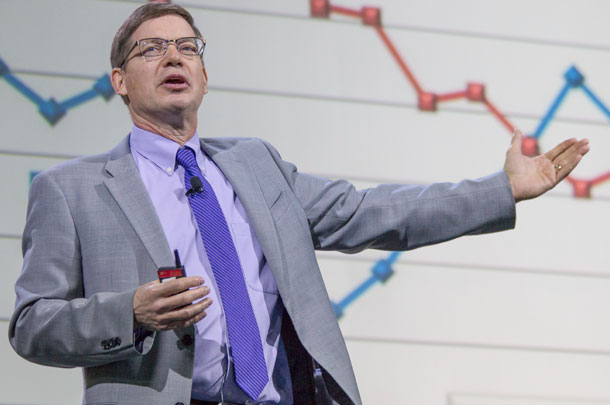At this time last year, CattleFax CEO Randy Blach told hopeful attendees that markets were likely to find lows down in the mid-teens, but as producers are aware, that wasn’t the case.
“I think it’s important that we address those things that changed so that we all understand what is driving our business,” Blach told CIC attendees in Nashville on Feb. 2. “We ended up harvesting a lot more cattle, particularly in the last three to four months of the year, than what we had forecasted.”
Blach said harvest levels were up 1.5 million more fed cattle in 2016 than 2015 – he thought that number would be less than 1 million a year ago.
“Another thing that I think we all need to recognize is that when we stood up here, I shared with you our concerns about not having enough harvest capacity as we get into 2018 and 2019, based on how many more cattle we are going to have come through production systems,” Blach said. “We didn’t expect that to become as big of an issue in 2016 as it did.”
Looking ahead, Blach expects the cattle markets to be more stable in 2017 when compared with the past three years. However, lower lows and lower highs are still expected, but at a more modest decline from recent years.
“I know volatility is on everyone’s mind,” Blach said. “We’ve been in a situation in the last two years where we’ve seen a market that has moved 41 to 45 percent – that’s been our change from highs to lows over the course of a year. The long-term average has been 21 percent. If I take it back all the way to 1970, from highs to lows over the course of a year, that would be our price range and we’ve doubled that.”
The historical cattle cycle remains intact, Blach said, although the price peak experienced in 2016 was the fastest and deepest of any in recent history.

Three years of expansion
It’s been three years since a major drought caused many in the Southern Plains region to destock their cow herd, said CattleFax analyst Kevin Good. Since then, improved weather conditions, coupled with lower input costs, have led the beef industry to expand at a rather rapid pace.
“We increased the beef herd an additional 1 million head this past year,” Good said, repeating Blach’s remarks. “Beef cow slaughter was up 14 percent in 2016, but nonetheless, it was still at a level that would suggest the industry is still expanding.”
Total cattle inventories in the U.S. have increased nearly 5 million head in three years – totaling 93.4 million in 2017. In particular, the beef cow inventory has grown 2.2 million head in three years to 31.2 million head as of Jan. 1.
Lower input costs and favorable feed conditions suggest that the beef cow herd could expand by another 400,000 head over the next two years. Good mentioned that larger supplies will lead to lower prices going forward; however, demand will largely determine the magnitude of the downtrend.
Fed cattle prices are expected to average near $110 per hundredweight (cwt); that’s down 9 percent from last year. Good told producers to expect 750-pound steers to average $130 per cwt and 550-pound steers to average $150 per cwt in 2017.
Utility market cows are expected to see a softer market in 2017 at $65 per cwt, with spring highs in the upper $70s and lows in the low $50s. Bred cows are expected to average near $1,300 per head this year.
Keeping up with the numbers
A point of concern for the industry is packing capacity. Good explained that the expanding beef supply continues to outpace facility growth, and will continue to be a challenge for market participants over the next few years.
“Shackle space is limited, and at the same time, as we look at the slaughter levels last year that increased 1.5 million head, we are suggesting that it will increase 8 to 900,000 head this year,” Good said. “It will continue to increase going forward because of where we are at in the cattle cycle.”
Good explained that the profit incentive for packers is there to move the additional protein supply; however, labor will continue to be an issue. He expects to see expanded kills, as far as capacity, and more Saturdays put in place moving through the rest of the year. He also expects to see discounts on heavyweight carcasses.
Trade and consumer demand
Demand will be the ultimate driver of price values within the various protein segments, but export growth will be key in improving those values. Meat exports are forecasted to increase over the next several years, but the rate of growth will largely determine the price risk for this cattle cycle.
“We think we will export more product – 1 out of every 4 pounds of increased protein production this year will be exported,” Good said. “That trend is positive, but at the same time, it still leaves more product on the domestic market. Even with population growth, we are still faced with increasing protein supplies, not only for this year, but over the next couple of years.”
In terms of the retail and restaurant segment, beef continues to be at a price disadvantage compared with its competitive proteins. This will stay a concern as the economy continues to grow at an ever-slow rate. ![]()

-
Cassidy Woolsey
- Editor
- Progressive Cattleman
- Email Cassidy Woolsey
PHOTO 1: Randy Blach, CEO of CattleFax, speaking at the 2017 NCBA Cattle Industry Convention.
PHOTO 2: Kevin Good, CattleFax analyst, speaking at the 2017 NCBA Cattle Industry Convention. Staff photos.







